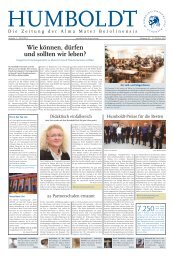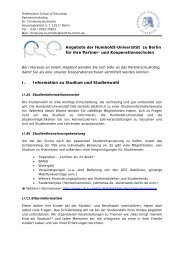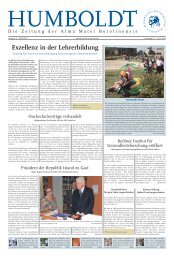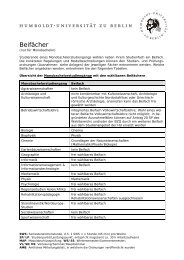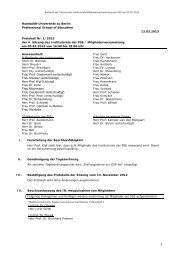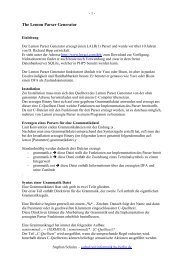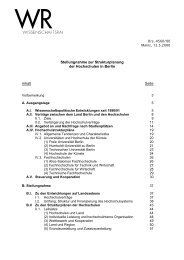hu wissen 3 (pdf) - Humboldt-Universität zu Berlin
hu wissen 3 (pdf) - Humboldt-Universität zu Berlin
hu wissen 3 (pdf) - Humboldt-Universität zu Berlin
Erfolgreiche ePaper selbst erstellen
Machen Sie aus Ihren PDF Publikationen ein blätterbares Flipbook mit unserer einzigartigen Google optimierten e-Paper Software.
Die Mikrobiologen der HU sind<br />
bereits jetzt in der Lage, mit<br />
Hilfe von Hydrogenasen aus<br />
Licht und Wasser umweltfreundlichen<br />
Wasserstoff <strong>zu</strong> gewinnen<br />
Microbiologists from the Department<br />
of Biology at HU are already<br />
in a position to produce environmentally-friendly<br />
hydrogen from<br />
water and light<br />
He has already managed to mimick part of the enzyme active<br />
centre using molecules and to simulate its activity. Limberg also<br />
tests the catalytic potential of the model compounds developed by<br />
the chemists.<br />
Another type of enzymes that Limberg is partially recreating<br />
in collaboration with HU biologists are hydrogenases, which can<br />
produce molecular hydrogen. Microbiologists Oliver Lenz and<br />
Bärbel Friedrich from the Department of Biology at HU are already<br />
in a position to produce environmentally-friendly hydrogen<br />
from water and light using hydrogenases and the photosynthetic<br />
apparatus of a cyanobacterium. »The problem is that hydrogenases’<br />
metal centres not only react with hydrogen, but also with oxygen,<br />
which deactivates or destroys the enzymes,« says Lenz. This<br />
negative attribute limits the biotechnical applications of conventional<br />
hydrogenases. However, there are a small number of hydrogenases<br />
that are barely affected by oxygen. Why some hydrogenases<br />
are oxygen resistant or tolerant and some are not is<br />
something that Lenz was recently able to work out in cooperation<br />
with partners at UniCat, the University of Oxford and the Max<br />
Planck Institute for Dynamics of Complex Technical Systems. »We<br />
were able to show that oxygen-tolerant hydrogenases have a<br />
highly specialised electron transport chain, which can transfer<br />
electrons to the active centre where they convert harmful oxygen<br />
into harmless water.« Furthermore, the HU microbiologists recently<br />
teamed up with partners at the Charité to use X-ray crystallography<br />
to examine the 3D structure of an oxygen-tolerant hydrogenase.<br />
»The enzyme has an iron-sulp<strong>hu</strong>r centre − something we<br />
have never seen before − which acts as an electronic switch that<br />
plays a key role in ›detoxifying‹ the otherwise harmful oxygen.« As<br />
well as focusing on hydrogenases, HU chemists are also performing<br />
modelling studies on oxygenases. They are able to use oxygen<br />
to oxidise hydrocarbons into more valuable substances. These important<br />
reactions are also the key area of another Cluster research<br />
group, headed by theoretical chemist Professor Joachim Sauer.<br />
The team is searching for suitable heterogeneous catalysts – purely<br />
inorganic solids which facilitate reactions on their surface.<br />
138



